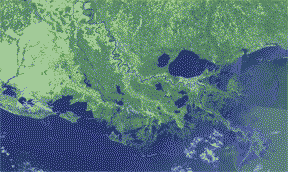U.S. Geological Survey
Third in the 2003 "Science, Society, Solutions" series
Everyone is welcome to attend this briefing. Learn how USGS science is supporting the rehabilitation of this intricate and vital ecosystem.
Other Science, Society, Solutions Briefings
| Friday, July 18, 2003 10:00 a.m. - 11:00 a.m. Rayburn House Office Building Room 2325 Washington, DC Refreshments will be served |
Speakers: (Speaker Biographies) Chip Groat Director, USGS Jack C. Caldwell Secretary, Louisiana Department of Natural Resources William R. Dawson Chief, Planning and Policy Division, U.S. Army Corps of Engineers |
| Hosted by: The following links leave the USGS site. The Coalition to Restore Coastal Louisiana | Congressional Sponsors: The following links leave the USGS site. Representative Tom Davis Representative James Moran |
| | |
| For information on the status of the July 18 Northern Gulf Coast Briefing on Capitol Hill, please call 703-648-4455. | |
Directions to Rayburn House Office Building:
East on Rt. 66 over the Roosevelt Bridge; right on Independence Avenue. Follow Independence past the construction of the Botanic Gardens; right on Canal Street (2 blocks); left on D Street. Pay parking is on the right between D Street and Canal Street.
 |
The economic vitality and environmental diversity of the Northern Gulf of Mexico are at growing risk from natural processes and human influences. Louisiana´s Gulf Coast is the last stop for drainage from more than 1 million square miles of the Mississippi River watershed before it pours into the Gulf. |


|
Louisiana´s Barrier islands provide a vital buffer for the fragile coastal wetlands, but these islands are threatened by rising sea level and hurricanes. This before-and-after pair of images shows the damage caused when Hurricane Georges roared throught the Chandeleur Islands in 1998. The erosion of protective barrier islands means that low-lying coastal communities and wetlands are subject to the full force of hurricanes and coastal storms. |
Chip Groat
Dr. Groat became the 13th Director of the U.S. Geological Survey, U.S. Department of the Interior in November of 1998. He is a distinguished professional in the earth science community with over 25 years of direct involvement in geological studies, energy and mineral resource assessment, ground-water occurrence and protection, geomorphic processes and landform evolution in desert areas, and coastal studies. Chip has held positions throughout his career in both academia and the public sector. Chip received his Bachelor of Arts degree in geology from the University of Rochester, his Master of Science in geology from the University of Massachusetts, and his Ph.D. in geology from the University of Texas at Austin. He has also served on over a dozen earth science boards and committees and has authored and contributed to numerous publications and articles on major issues involving earth resources and the environment.
Jack C. Caldwell
Mr. Caldwell was selected by Governor Mike Foster to serve as Secretary of the Louisiana Department of Natural Resources in January 1996. He serves in this capacity in the Baton Rouge office as well as branch offices throughout the state. Mr. Caldwell has testified on numerous occasions before Louisiana House and Senate committees and Congressional committees in support of coastal restoration legislation. In March 2003, he was honored by receiving the 2002 Professional Conservationist of the Year award from the Louisiana Wildlife Federation and the National Wildlife Federation. He is an honor graduate of both the LSU Law School and College of Commerce. Mr. Caldwell is a member of the LSU Law School Hall of Fame and has served the school as an adjunct professor. His private practice included oil and gas litigation and land and water law. He was named distinguished attorney for 1994 – 1995 by the Louisiana Bar Foundation.
William R. Dawson
William R. Dawson serves as the Chief of Planning and Policy Branch with the Headquarters, U.S. Army Corps of Engineers, in Washington D.C. The Branch formulates Army Civil Works policy with the Office of the Assistant Secretary of the Army for Civil Works, Federal and State agencies, and Office of Management and Budget. Mr. Dawson serves as the principal on policy and project matters with Congressional authorization and appropriation committees. Prior to his present position, he was Chief, Interagency & International Services Division, in the Directorate of Military Programs, at the Headquarters, from July 2002-May 2003. Mr. Dawson´s career extends over 30 years and encompasses diverse experience in positions and locations since joining the Corps in 1971. Mr. Dawson earned his B.S. degree in Civil Engineering from Virginia Tech, 1971, and M.S. in Environmental Engineering from University of North Carolina.